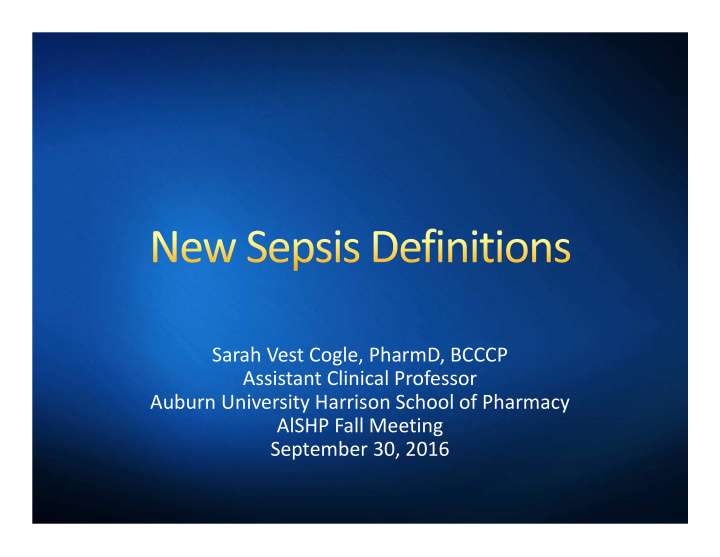



Sarah Vest Cogle, PharmD, BCCCP Assistant Clinical Professor Auburn University Harrison School of Pharmacy AlSHP Fall Meeting September 30, 2016
Pharmacists: Discuss the rationale for modifications to the sepsis definitions Describe the updated sepsis definitions (Sepsis‐3) Technicians: Define sepsis and septic shock
I have no actual or potential conflict of interest in relation to this program
Need to differentiate sepsis from infection Improved understanding of sepsis pathophysiology Previous definitions focused on SIRS criteria Variable definitions – inconsistent reporting Sepsis vs. severe sepsis Sepsis syndrome Septicemia Singer M, et al. JAMA . 2016;315(8):801‐810.
• Life‐threatening organ dysfunction Sepsis caused by a dysregulated host response to infection • Subset of sepsis in which profound circulatory, cellular, and metabolic Septic shock abnormalities are associated with a greater risk of mortality than with sepsis alone Singer M, et al. JAMA . 2016;315(8):801‐810.
Sepsis‐1 Sepsis‐2 Sepsis‐3 1991 2001 2016 Sepsis Systemic response to Presence of infection Life‐threatening organ infection with ≥2 SIRS with systemic dysfunction caused by a criteria manifestations of dysregulated host infection response to infection Severe Sepsis associated with Sepsis associated with *Severe sepsis removed sepsis hypotension, hypotension, hypoperfusion, or hypoperfusion, or organ organ dysfunction dysfunction (unchanged from 1991) Septic Sepsis‐induced Acute circulatory failure Subset of sepsis in which shock hypotension persisting characterized by profound circulatory, despite adequate fluid persistent arterial cellular, and metabolic resuscitation, along hypotension unexplained abnormalities are with hypoperfusion by other causes associated with a greater abnormalities or organ risk of mortality than dysfunction with sepsis alone Bone RC, et al. Chest . 1992;101:1644‐55. Levy MM, et al. Intensive Care Med . 2003;29:530‐538. Singer M, et al. JAMA . 2016;315(8):801‐810.
qSOFA SOFA • quick Sequential [Sepsis‐related] • Sequential organ failure Organ Failure Assessment assessment • Can be performed quickly • Can be more difficult to without laboratory values calculate but laboratory • Does NOT define sepsis parameters involved are • Score ≥2 associated with common • Higher scores = increased increased length of ICU stay and mortality mortality • If ≥2 , elevate further for organ • Suspected infection + SOFA dysfunction change from baseline ≥2 points = sepsis Seymour CW, et al. JAMA . 2016;315(8):762‐774. Singer M, et al. JAMA . 2016;315(8):801‐810.
Suspected infection Monitor, re‐evaluate for No No No possible sepsis if indicated Sepsis still qSOFA ≥2 suspected ? Yes Yes Yes Yes Assess for organ dysfunction Yes Yes No No SOFA ≥2 qSOFA Variables: • Respiratory rate (>22 BPM) Sepsi • Mental status s • Systolic blood pressure (<90 mmHg) Despite adequate fluid resuscitation, No No 1) Vasopressors required to maintain SOFA Variables: MAP ≥65 mmHg, AND • PaO 2 /FiO 2 ratio 2) Serum lactate >2 mmol/L • Glasgow Coma Score • Mean arterial pressure Yes Yes • Administration of vasopressors • Serum creatinine or urine output Septic shock • Bilirubin • Platelet count Adapted from: Singer M, et al. JAMA . 2016;315(8):801‐810.
Surviving Sepsis Campaign response Screening for early identification and treatment of patients with sepsis (formerly called severe sepsis) should continue Patients with sepsis should still be identified by the same organ dysfunction criteria Possibility for future use of qSOFA score to identify organ dysfunction Impact on coding, CMS core measures remains to be fully seen Surviving Sepsis Campaign. Surviving Sepsis Campaign responds to Sepsis‐3. 2016 Mar 3. Available from: http://www.survivingsepsis.org/SiteCollectionDocuments/SSC‐Statements‐Sepsis‐Definitions‐3‐2016.pdf
A 58 year old female presents to the emergency department with altered mental status, shortness of breath and fever Ht: 67” Wt: 68 kg T: 102°F RR: 32 BPM HR: 134 BPM BP: 88/44 mmHg BUN 41 mg/dL SCr 2.1 mg/dL WBC 19.4 x 10 3 cells/m 3 Lactate: 4.9 mmol/L Chest X‐ray: infiltrate in right lower lobe Her blood pressure does not respond to a 2L crystalloid fluid bolus and norepinephrine is initiated How would you classify this patient based on Sepsis‐3 definitions? a. Sepsis b. Severe sepsis c. Septic shock d. Septicemia
A 58 year old female presents to the emergency department with altered mental status, shortness of breath and fever Ht: 67” Wt: 68 kg T: 102°F RR: 32 BPM HR: 134 BPM BP: 88/44 mmHg WBC 19.4 x 10 3 cells/m 3 BUN 41 mg/dL SCr 2.1 mg/dL Lactate: 4.9 mmol/L Chest X‐ray: infiltrate in right lower lobe Her blood pressure does not respond to a 2L crystalloid fluid bolus and norepinephrine is initiated How would you classify this patient based on Sepsis‐3 definitions? a. Sepsis b. Severe sepsis c. Septic shock d. Septicemia
How would you classify this patient based on Sepsis‐3 definitions? a. Sepsis b. Severe sepsis c. Septic shock d. Septicemia Suspected infection (likely pneumonia based on Chest X‐ray, fever, shortness of breath, elevated WBC) with evidence of organ dysfunction that persists despite fluid resuscitation and elevated lactate (A and B are incorrect). Septicemia (answer D) is incorrect as it is an antiquated term that is not included in the Sepsis‐3 definitions. Septic shock (answer C) is the only correct answer based on this patient’s presentation. Singer M, et al. JAMA . 2016;315(8):801‐810.
Bone RC, Balk RA, Cerra FB, et al. Definitions for sepsis and organ failure and guidelines for the use of innovative therapies in sepsis. Chest . 1992;101:1644‐55. Levy MM. 2001 SCCM/ESICM/ACCP/ATS/SIS International Sepsis Definitions Conference. Intensive Care Med . 2003;29:539‐538. Singer M, Deutschman CS, Seymour CW, et al. The third international consensus definitions for sepsis and septic shock (Sepsis‐3). JAMA . 2016;315(8):801‐810. Seymour CW, Liu VX, Iwashyna TJ. Assessment of clinical criteria for sepsis for the Third International Consensus Definitions for Sepsis and Septic Shock (Sepsis‐3). JAMA . 2016;315(8):762‐774. Surviving Sepsis Campaign. Surviving Sepsis Campaign responds to Sepsis‐3. 2016 Mar 3. Available from: http://www.survivingsepsis.org/SiteCollectionDocuments/SSC‐ Statements‐Sepsis‐Definitions‐3‐2016.pdf
Recommend
More recommend